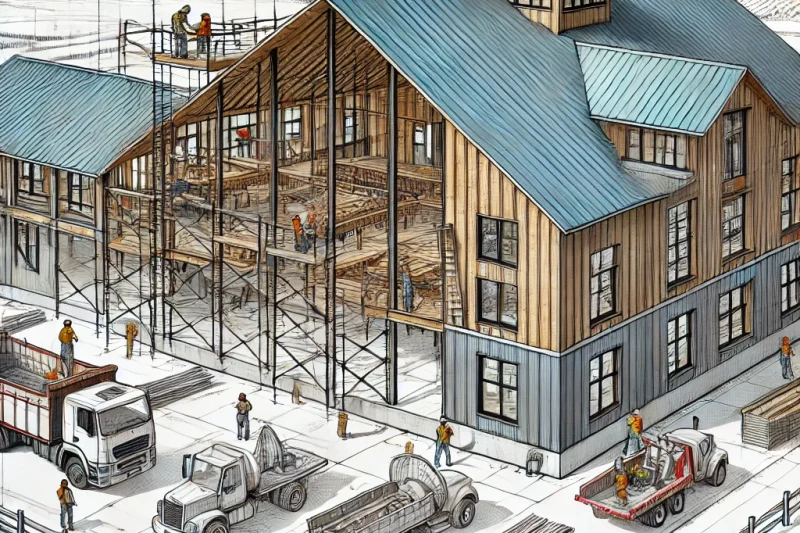Buy in Bishop Hill, IL with No Money Down!
“Unlock the Power of USDA Mortgages with Smart Mortgage!”
Bishop Hill, IL USDA Home Loan Guide
What is a Bishop Hill, IL USDA Mortgage?
Welcome to the Smart Mortgage guide on USDA Mortgages. Navigating the home financing world can be a daunting task, but understanding the various mortgage options available can significantly streamline the process. One such option that you might not be familiar with is the Bishop Hill, IL USDA mortgage. Let’s dive in.
1. Overview
A USDA mortgage, formally known as the USDA Rural Development Guaranteed Housing Loan, is a mortgage loan offered to rural property owners by the United States Department of Agriculture (USDA). Designed primarily to promote Illinois homeownership in rural and some suburban areas, the Bishop Hill USDA loan comes with a range of benefits that make it a viable option for eligible homebuyers.
2. Key Features
- No Down Payment: One of the standout features of a USDA loan in Bishop Hill, IL is the possibility of financing up to 100% of the home’s price. This means eligible borrowers can buy a Illinois home with no down payment.
- Competitive Interest Rates: Typically, USDA loans come with interest rates that are either at or below the market rate.
- Flexible Credit Guidelines: USDA loans often have more lenient credit requirements, which can be beneficial for those with a less than perfect credit history.
Bishop Hill FL USDA Loan Questions Call (888)416-4805
Get cash from your home.
Apply to see how a cash out refinance can help you.
Homebuyer Seminars
Discover the keys to homeownership at our local home buying seminar – your first step towards securing your dream home!
See our home loans.
Explore our diverse range of home loan programs tailored to fit your unique needs!
3. Eligibility Criteria
To be eligible for a Bishop Hill, IL USDA mortgage, borrowers must meet certain requirements:
- Location: The Bishop Hill, IL property must be located in an eligible rural or certain suburban area as defined by the USDA.
- Income Limits: There are specific income requirements, both minimum and maximum, based on the median income of the area.
- Creditworthiness: While the USDA is generally more lenient with credit scores, a certain credit standard must still be met.
- Primary Residence: The borrower must occupy the home as their primary residence.
4. Benefits of a USDA Mortgage
- Affordability: With no down payment and the potential for lower mortgage insurance premiums, a Bishop Hill, IL USDA loan can be more affordable in the long run.
- Inclusive: It’s a great option for Bishop Hill, IL first-time homebuyers or those without a substantial savings for a down payment.
- Supporting Rural Development: By opting for a USDA mortgage, you’re indirectly supporting the development and sustainability of rural communities.
5. How Smart Mortgage Can Help
Navigating the intricacies of USDA mortgages can be challenging. That’s where Smart Mortgage steps in. Our team of seasoned USDA mortgage professionals is here to guide you through every step, ensuring you make informed decisions tailored to your needs. Whether you have questions about your eligibility or the application process, we’re here to help.
Take the Next Step Interested in exploring if a Bishop Hill, IL USDA mortgage is right for you? Get in touch with our Smart Mortgage team today at (888)416-4805. We’re committed to helping you find the best mortgage solution for your unique situation.
Do you need a Pre-Approval?
We are here to help! Get a same day Bishop Hill, Illinois USDA pre-approval to shop for your dream home!
Mortgage Resource Center

USDA Loans in Illinois: Benefits, Eligibility, and Popular Cities
Buying a home is a significant milestone, and for many, finding the right loan program makes all the difference. If you're considering Read more
Barndominium Financing Made Easy with iLoanUSDA
Barndominium Financing Made Easy with iLoanUSDA: Your One-Time Construction Loan Solution Barndominiums, the stylish and practical combination Read moreMore information About Bishop Hill, Illinois
Bishop Hill is a village in Henry County, Illinois, United States, along the South Edwards River. The population was 128 at the 2010 census, up from 125 in 2000. It is the home of the Bishop Hill State Historic Site, a park operated by the Illinois Historic Preservation Agency.
Bishop Hill is located at 41°12′3″N 90°7′6″W / 41.20083°N 90.11833°W / 41.20083; -90.11833 (41.200711, -90.118327).
According to the 2010 census, Bishop Hill has a total area of 0.53 square miles (1.37 km2), all land.
The village was founded in 1846 by Swedish immigrants affiliated with the Pietist movement, led by Erik Jansson. Prior to founding the Bishop Hill Colony, Jansson preached to his followers in Sweden about what he considered to be the abominations of the Lutheran Church and emphasized the doctrine that the faithful were without sin. As Jansson’s ideas became more radical, he began to lose support from many of his sympathizers and was forced to leave Sweden in the midst of growing persecution. Jansson had previously sent Olof Olsson, a trusted follower, as an emissary to the United States to find a suitable location where the Janssonists could set up a utopian community centered on their religious beliefs. According to Jansson, this community would become the “New Jerusalem”, and their beliefs would soon spread across the world. As a result, 1400 colonists emigrated from Sweden to their new home in western Illinois.
The colony struggled early on after its founding. Many of the first 1000 colonists died from disease on the way to Bishop Hill (named for Eric Jansson’s birthplace, Biskopskulla ), while others became disillusioned and stayed in New York. The quarters in Bishop Hill were cold and crowded and food was scarce. After the first winter, life at the colony began to improve. In the next few years housing was upgraded from dugouts to brick living areas, and crops were planted on 700 acres (2.8 km2) of land. By 1849, Bishop Hill had constructed a flour mill, two sawmills, a three-story frame church, and various other buildings. The Bishop Hill Colony was communistic in nature, as dictated by Jansson. Thus, everything was owned by everyone and no one had more possessions than another. Work in the colony was highly rigorous and regimented. It wasn’t uncommon to see hundreds of people working together in the fields or large groups of laborers engaged in other tasks.
We Service the Following Locations in Florida



